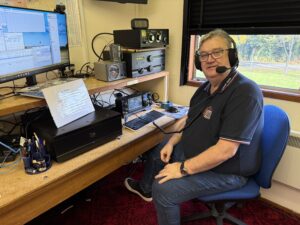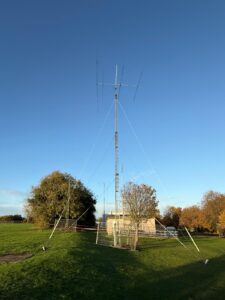 Following on from our success, and fun we had, in the CQWPX SSB contest in March 2025 The Royal Signals Amateur Radio Society (RSARS) contest team decided to take part in the CQWW DX SSB contest This contest is held annually on the last full weekend of October each year, this is a 48 hour contest starting at 00:00 UTC on the Friday and running through to 00:00UTC on the Sunday evening. The aim is to make contact with as many different stations on the HF amateur bands – 160, 80, 40, 20 15 and 10M – in as many different countries and CQ Zones around the world. There are also CW and RTTY events held on the last full weekends of November and September respectively.
Following on from our success, and fun we had, in the CQWPX SSB contest in March 2025 The Royal Signals Amateur Radio Society (RSARS) contest team decided to take part in the CQWW DX SSB contest This contest is held annually on the last full weekend of October each year, this is a 48 hour contest starting at 00:00 UTC on the Friday and running through to 00:00UTC on the Sunday evening. The aim is to make contact with as many different stations on the HF amateur bands – 160, 80, 40, 20 15 and 10M – in as many different countries and CQ Zones around the world. There are also CW and RTTY events held on the last full weekends of November and September respectively.
RSARS have been kindly donated a building, The Cole Block, on the army garrison at Blandford Camp, in the town of Blandford Forum, Dorset. We have a permanent station there that is used regularly by members stationed on the camp, club members visiting, and guests who are invited to attend at special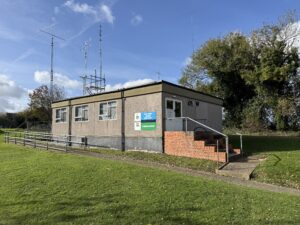 events. I have been a member of RSARS for the past 18 months and first attended for the CQWPX contest in March 2025.
events. I have been a member of RSARS for the past 18 months and first attended for the CQWPX contest in March 2025.
RSARS was established in 1960 and has been dedicated to the development and growth of communication skills among Royal Signals personnel, veterans, and those with a connection to the military community ever since. The group was originally founded with the authority of the War Office by General Whistler and Brigadier Eric Cole. The idea was to provide serving members of the Royal Signals a route to deepen their knowledge of radio communications and associated technologies through self-training. As amateur radio was already recognised as a military pastime, they offered a perfect blend of practical skill development and technical challenges. Originally based at Catterick Garrison, there was a move to Blandford Camp in Cole Block – a location steeped in heritage and significance.
So after some discussion we decided to get together for CQWW SSB contest this year, again to have fun on the radio with friends, make as many contacts to score as many points possible, and finish as high up in the results in our category. We finished 2nd in the UK in our section of the CQWPX contest in March 2025, only being beaten by an established team of experienced operators, and we only operated for a total of 34.2 hours of the contest. This time deficit was due to the team getting to know each other especially as it was the first time some of us had met, 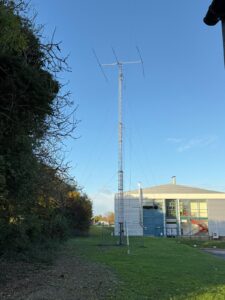 maintenance on the antennas, and some interruptions from the many visitors who stopped by to see what was happening. We also stopped to have tea and drinks during the Saturday and Sunday to chat and plan tactics. But this time around we were hoping to operate for the full 48 hours on all bands and get further up the table, and there will be more stations in our category to try and beat.
maintenance on the antennas, and some interruptions from the many visitors who stopped by to see what was happening. We also stopped to have tea and drinks during the Saturday and Sunday to chat and plan tactics. But this time around we were hoping to operate for the full 48 hours on all bands and get further up the table, and there will be more stations in our category to try and beat.
At this point I must say thanks to the garrison commander that we are able to take part in this activity with her being so supportive of the club. The Cole Block is a single story building with 2 offices and a large sitting area. We decided that one office would be used for sleeping and storage of boxes and our kit, one is the permanent shack with an Icom IC-7610 and Acom 1000 amplifier, a Yaesu FT-990 connected to a Yaesu FL-7000 amplifier and an Icom IC-756 connected to Ameritron AL-80B amplifier. Tom also brought his IC-756 Pro3 along and hooked it up to a Kenwood TL-922 amplifier, Ady had his Elekraft K4 and Acom 1000 and his IC-7300 as a spare, Tom also brought along his spare TL-922 just in case we needed it. And with me now working at Icom UK I was kindly loaned an Icom IC-7760 flagship radio for the weekend and this was used in the main shack area, thank you Bob (my boss).
So we could be on all bands we used all available desks to set up the equipment. This gave 4 operating positions, and with only 5 operators on site for the full contest and visitors calling in through Saturday and Sunday we felt this would give us maximum time to each be on air and on the main bands to get the scores we would need to finish as high up the table as possible.
Antennas to be used were the clubs 3 element tri-band Yagi with a 10M parasitic element added to give us 4 element on 10M, along with a 3 element tri-band Yagi used for 15M and 20M. Both are mounted on the 60 foot towers with a doublet suspended between them fed into a balun and then into an automatic antenna tuner to get the impedances right. Ady brought along his home made full size 1/4 wave vertical for 80M, and we have a 4 square antenna for 40M – which also works on 15M – that had been built and was very successful in the CQWPX event earlier in the year.
are mounted on the 60 foot towers with a doublet suspended between them fed into a balun and then into an automatic antenna tuner to get the impedances right. Ady brought along his home made full size 1/4 wave vertical for 80M, and we have a 4 square antenna for 40M – which also works on 15M – that had been built and was very successful in the CQWPX event earlier in the year.
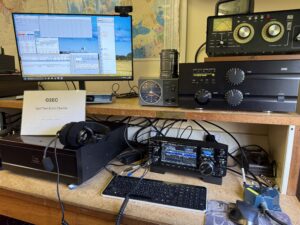 The IC-7760 was to be used on 10M, 80M and 160M using the clubs Acom 1000 to the 4 element Yagi and 80M Vertical – and tried the doublet for 160 with limited success – and the 100W output from the radio to the doublet mounted between the 2 towers the Yagis. The Clubs 7610 was also 80M through the Ameritron, sadly the Ameritron failed so we only had 100W from the radio. Tom set his 756 on the 40M 4 square we had built for CQWPX and was able to use it on 15m, and the K4 went on 20M through the 3 element Yagi and Acom 1000, and doubled up on 15M when the 40M band was rocking.
The IC-7760 was to be used on 10M, 80M and 160M using the clubs Acom 1000 to the 4 element Yagi and 80M Vertical – and tried the doublet for 160 with limited success – and the 100W output from the radio to the doublet mounted between the 2 towers the Yagis. The Clubs 7610 was also 80M through the Ameritron, sadly the Ameritron failed so we only had 100W from the radio. Tom set his 756 on the 40M 4 square we had built for CQWPX and was able to use it on 15m, and the K4 went on 20M through the 3 element Yagi and Acom 1000, and doubled up on 15M when the 40M band was rocking.
Almost all the members present own at least 1 Icom radio, which with their simplicity of operating made it easy to move from one to the other as the controls are so instinctive to use. Ady set his K4 up and as on the Icoms we found it easy to use, not really having to change any settings, just tune the amp which again we were all familiar with from using the equipment in March.
From the off we were making good runs on the chosen bands, the 80M vertical was on with the 7610 and Ameritron but we were struggling to get any output from the amp and tried to cure the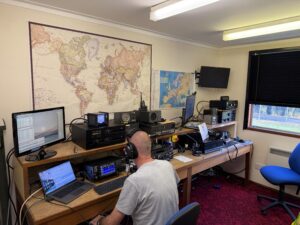 issue, meanwhile Ady was on 20, Chris using the 7760 on 160 trying to get some “bonus points” with us not having a tuned antenna for the band. As it was a struggle after about an hour it was decided to switch the 80M vertical on to the 7760 and Acom to maximise that band and points. Tom was trying to find a clear spot on 40M, but as he said it was that busy “you can’t get a fag paper between the stations”. This was much the story all weekend with us rotating and taking breaks for sleep, though mostly it was for a couple of hours here and there.
issue, meanwhile Ady was on 20, Chris using the 7760 on 160 trying to get some “bonus points” with us not having a tuned antenna for the band. As it was a struggle after about an hour it was decided to switch the 80M vertical on to the 7760 and Acom to maximise that band and points. Tom was trying to find a clear spot on 40M, but as he said it was that busy “you can’t get a fag paper between the stations”. This was much the story all weekend with us rotating and taking breaks for sleep, though mostly it was for a couple of hours here and there.
Tea and coffee was flowing and made by any operator who was not at the desk. We grabbed food when we were not on shift and this again was erratic like the sleep. We also had times where we would all sit round and chat trying to work out a strategy for getting maximum points possible. We even had times where no matter how much we tuned up and down the bands we were only hearing the stations we had already worked, even when having a run (calling CQ) we were getting called by duplicates, especially on the Sunday when it got really hard. Another thank you here, Martin (2E0HVE) brought pizzas in on the Sunday afternoon so we all stopped and had a chat, Inghi (M0MHJ) also called in at this time so they both got on the air and put some points on the board while the others had lunch.
Score wise we ended on 3000 contacts and 2,944,800 points before we get our final score from the checks for any errors. At the end we were talking and planning for the CQWPX 2026 event in  March to get together again for some fun on air. We had a fun weekend with all members who attended having a go. We had a couple of new to contesting guys attend and made contacts – all saying how they enjoyed it and asking when we were next going to have a go.
March to get together again for some fun on air. We had a fun weekend with all members who attended having a go. We had a couple of new to contesting guys attend and made contacts – all saying how they enjoyed it and asking when we were next going to have a go.
Every radio performed flawlessly, with the same thing being said by every team member who used the IC-7760 on how much a pleasure it was to use. They commented on how they found moving from the 7610 to the 7760 was so easy and it was as if they were using the same radio – as I explained they were in effect as the human interface side is just about exactly the same (as said earlier just a few features more on the 7760 over the 7610). The 756 Pro3 also never missed a beat, and was excellent on the crowded 40M band, working everything we could hear. At one time there was “not a cigarette paper” between the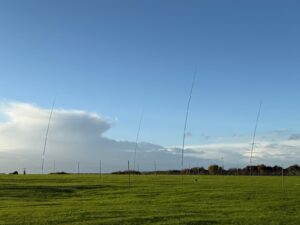 stations transmitting on there.
stations transmitting on there.
Currently we are looking at entering the CQWPX contest in 2026 and try to improve our position from this year. Then the society will be active from the club using a different call to the contest call we used at regular periods. They are looking at putting a D-Star repeater in place of the current one there for FM and Fusion, this is due to many locals using Icom equipment on the VHF/UHF bands and have asked if this can be done.
My thanks go out to the guys who were there for all the fun, laughter, and hard work that was put in to get this up and running. The full team was Ady G6AD, Tom G2NV, Tim G5TM, Tony G7FSD, Inghie M0MHJ, Martin 2E0HVE, and myself G1VDP. Again we welcome any members of RSARS to come and join us, just to have a go and see what contesting is all about, you don’t have to be a seasoned operator either, just come and have a go, it may be fun – which is what we all enjoy.
RSARS are open to membership from any radio amateur or Short Wave Listener. They have a website at https://rsars.org.uk/ where full details of the membership can be found. There is a quarterly newsletter called Mercury published electronically and emailed to members quarterly’ covering articles of interest to members on varying subjects. Membership is currently £12.00 per year, all members are welcome to join the RSARS nets held daily on 40 or 80M and to operate from the club station. And we invite you to join us for the contests to assist with operating and set up before and strip down after. Contact Tom, G2NV, for more details memsecrsars@gmail.com. 


